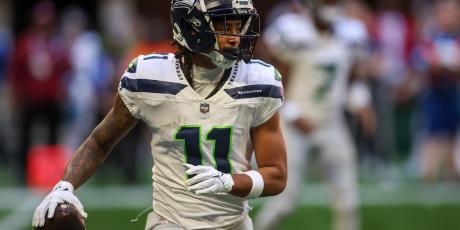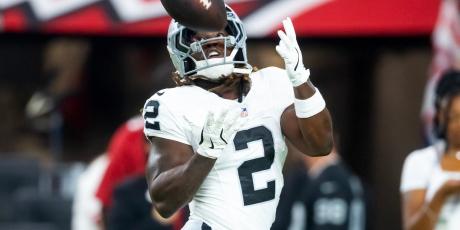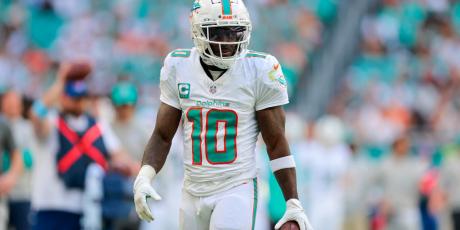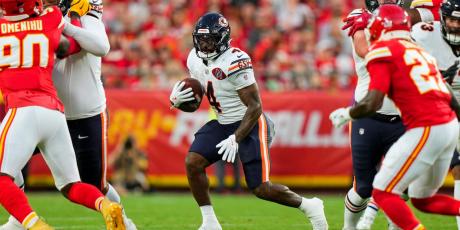Trey Lance Should Start the 2021 Season for the 49ers

I’ve always loved to learn about history. Specifically, I am fascinated by the forgotten origins of common things today, the secret quirks behind famous historical events, or people who end up as total societal outliers. These people and events serve as a kind of test case in a historical sociological experiment: either the narrative absorbs their weirdness into the big picture, or their actions make enough impact to change the status quo. In football terms, this could mean talking about a trailblazer like Fritz Pollard, what happened behind the scenes in the Super Bowl where the lights went out, or even the evolution of the “prolate spheroid” shape of the ball.
My love for the historically bizarre means moments like San Francisco 49ers quarterback Trey Lance getting drafted third overall this year leave me feeling tingly. Lance (formerly of North Dakota State) became just the fourth non-FBS quarterback selected in the first round in the last 30 years—a massive achievement for a small-school passer.
Many have cited this huge leap in level of competition as a reason why Lance could end up mostly “redshirting” his rookie season in the NFL. Will 2021’s third overall pick play this year, and what will his inaugural campaign look like?
Progress Comes in Fits and Starts
The first step to Lance’s career is getting on the field, but even that pathway is littered with historical footnotes.
There have been 44 quarterbacks taken in the first round of the NFL Draft over the last 15 years (2006–2020 draft classes). Of those 44, no one has played fewer college games (19) than Lance. Among fellow 20-year-olds selected, the average college games played was 34.0—nearly double Lance’s experience. Almost all of his age-level peers also played at major Power-Five programs against future NFL talent, while Lance again was plying his trade in the FCS’s Missouri Valley Conference. It seems logical to assume, then, that the 49ers are expecting a slower developmental road for their quarterbacking heir apparent.
Of course, things aren’t ever that simple.
Among the 10 first-round quarterbacks to play fewer than 30 collegiate games in our sample, six started right away out of training camp, and eight started by Week 3. In fact, when comparing these lesser-experienced passer prospects to the 34 who played in 30 or more games in the NCAA, they averaged a start 2.4 games into their first season (starting in Week 3 or 4) while the latter group averaged a start 4.9 games into their career (starting in Week 5 or 6). It’s not a huge difference, but it underlines an interesting possibility: the higher an NFL team drafts a young, inexperienced quarterback, the more confidence they have in his early development, not less.
The table below shows the split in the college production rates between passers drafted with 29 or fewer and 30 or more college games under their belts. There’s a compelling difference in the samples.
| College Experience | Draft Pick | Games | Completion Rate | Pass YPA | Touchdown Rate | Interception Rate | Passer Rating |
|---|---|---|---|---|---|---|---|
| 29 or Fewer Games | 9.8 | 25.1 | 64.6% | 8.6 | 7.0% | 2.5% | 157.6 |
| 30 or More Games | 9.6 | 36.8 | 63.4% | 8.2 | 6.5% | 2.3% | 150.5 |
Almost across the board, the passers with less experience who get drafted high have produced better in college than their more experienced peers. Gone is the iron-clad Bill Walsh mantra that under-experienced signal-callers are a no-go; here is a sliding scale of experience to upside that makes a gamble on a smaller sample size worthwhile. Lance turned in a 65.4% completion rate, 9.3 yards per attempt, a 9.4% touchdown rate, a 0.3% interception rate, and an NCAA Passer Rating of 173.8.
The final note on when Lance might end up starting is that teams invest a lot of draft capital, scouting and development time, and myriad other resources into an early draft pick at quarterback. For those reasons, quarterbacks drafted high don’t typically sit these days. Still, the higher they’re drafted, the earlier they tend to start.
| Draft Range | Team Games Before First Start |
|---|---|
| 1st to 16th | 3.3 |
| 17th to 32nd | 9.1 |
| 1st to 5th | 2.2 |
| 6th to 32nd | 6.6 |
Trey Lance is a triple-threat: he’s incredibly young, produced extremely well in college, and because of those factors his team trusted him enough to draft him third overall (not to mention trading a king’s ransom of future picks to get there). I’d be shocked if Lance isn’t starting at the latest by Week 4 of the 2021 season.
History Repeats Itself
Since becoming an offensive coordinator in 2008, current 49ers head coach Kyle Shanahan has game planned for quarterbacks of all sorts: the popgun pocket passers like Brian Hoyer and Rex Grossman, the field maestros like Matt Ryan and Matt Schaub, the electric playmakers like Robert Griffin III and Donovan McNabb. He has even pieced together passable performances from career backups and busts when his starters have (frequently) gone down to injury.
Despite the wide range of talent and varied skillsets he’s had to work with, Shanahan’s offenses have had consistent outcomes. The table below shows his offense’s annual finish among NFL teams since taking over for the 49ers in 2017, per Pro Football Reference.
| Kyle Shanahan | Total Yards | Total Pts | Pass Attempts | Pass Yards | Pass TD | Pass Int | Net Yards per Attempt |
|---|---|---|---|---|---|---|---|
| 2017, SF | 12th | 20th | 2nd | 9th | 28th | 23th | 16th |
| 2018, SF | 16th | 21st | 20th | 15th | 17th | 30th | 11th |
| 2019, SF | 4th | 2nd | 29th | 13th | 10th | 18th | 3rd |
| 2020, SF | 15th | 21st | 16th | 12th | 19th | 30th | 13th |
| Career Average | 10th | 17th | 14th | 11th | 18th | 20th | 11th |
You may not like Shanahan, you might dispute his reputation as an offensive mastermind, but he is at least consistent and gets pretty regular results. Despite starter Jimmy Garoppolo being injured for more than half of his time in San Francisco, the Niners have had a top-half passing offense in almost every category over that span—a fairly impressive feat. A grain of backup quarterback-influenced salt has to be taken with the poor touchdown and interception end-of-year rankings, but even Shanahan’s career averages show these as worse than league average and significantly lower than the passing yards and passing attempts rankings. This happens despite a high average ranking for passing attempts, passing yards, and net yards per attempt. All of this seems to indicate the Shanahan offense utilizes passing to set up the run game (15th in attempts, yards, and yards per attempt; 12th in touchdowns).
Not much from Shanahan’s offense should change with Lance under center. This will likely end up a balanced offense between run and pass, relying on play-action to generate high yards per attempt throws and setting up the backfield as playmakers.
This plan meshes well with Lance’s hyper-efficient passing profile and mobility, as he showed in his one full season that he was one of the most efficient passers in this class. The table below shows Lance’s percentiles in these categories among FCS quarterbacks with at least 250 attempts in 2019.
| Attempts | Completion Rate | Yards per Attempt | Touchdown Rate | Interception Rate | Sack Rate | Passer Rating | |
|---|---|---|---|---|---|---|---|
|
2019
|
0.18 | 0.97 | 1.00 | 0.98 | 1.00 | 0.83 | 1.00 |
Lance’s relatively low number of attempts is offset by 93rd percentile or higher marks among his smaller-school peers. It’s always tough to translate lower-level production in college football to the numbers posted by the big schools, but Lance absolutely dominated lesser competition, which is all one can ask for. If you were to take those percentiles and transfer them over to a comparable 2019 quarterback in the FBS, you would match the hyper-efficient 2019 season of Alabama’s Tua Tagavailoa (1st percentile in pass attempts; 96th or higher in completion rate, yards per attempt, touchdown rate, and interception rate). In short: his arm? It's good.
Shanahan has also benefited even his most molasses-footed quarterbacks’ fantasy value on the ground. The table below depicts the season-starting quarterbacks Shanahan has had since 2008, comparing their designed rushing attempts (per Pro Football Focus) per game in and outside of a Shanahan offense.
| Quarterback | Years | Games with Shanahan | Designed Runs per Game | Non-Shanahan Designed Runs per Game | Difference per Game | Difference by Percentage |
|---|---|---|---|---|---|---|
| Matt Schaub | 2008-2009 | 27 | 1.81 | 0.68 | +1.14 | +167.0% |
| Donovan McNabb | 2010 | 13 | 1.08 | 1.18 | -0.11 | -9.0% |
| Rex Grossman | 2011 | 13 | 1.23 | 1.27 | -0.04 | -3.0% |
| Robert Griffin III | 2012-2013 | 28 | 4.46 | 2.39 | +2.07 | +86.6% |
| Brian Hoyer | 2014 | 14 | 1.43 | 1.07 | +0.36 | +33.3% |
| Matt Ryan | 2015-2016 | 32 | 1.25 | 1.01 | +0.24 | +24.3% |
| Jimmy Garoppolo | 2017-2020 | 31 | 1.71 | 1.24 | +0.47 | +38.4% |
| All | 158 | 2.01 | 1.06 | +0.95 | +89.7% |
Only the breaking-down McNabb and the never-built-up Grossman had fewer designed rushes per game with Shanahan calling the shots than not. Even adjusting for non-starter snap counts with players like Griffin and Schaub who lost their jobs eventually, Shanahan got his passers moving more by an average of one additional rush per game—an almost 90% increase.
Lance’s frame and athleticism (hand-clocked in the mid-4.5s in the 40-yard dash and highlight darling) is far closer to fellow top-three selection Griffin’s than the stone-footed mammoth Ryan.
Trey Lance had a GPS tracked time at 21.54 MPH on this run.
That would of made him the 14th fastest ball carrier in the NFL last year right behind Will Fuller but ahead of AJ Brown.
Lamar Jackson's 2 fastest times in 2020 were at 20.64 and 20.52 MPH.👀#TreyLance #49ers pic.twitter.com/jdsuCpohjK
— John Chapman (@JL_Chapman) May 3, 2021
It’s not out of the realm of possibility to imagine Lance seeing four or more designed runs a game with a few scrambles to boot like peak Griffin had. These 65 to 100 rushing attempts would be a huge boon for his fantasy outlook, helping to stabilize his production profile in case of low passing production games.
The Bottom Line
- First-round rookie quarterbacks tend to play early in their careers. The higher they are drafted, the more likely they are to see the field early on, and most start by Week 4 of their first season in the NFL.
- 49ers head coach Kyle Shanahan runs a very consistent scheme year-in, year-out and will likely expect Trey Lance to fill a low passing volume but high-efficiency role in that offense. The makeup of Ryan Tannehill’s role with the Tennessee Titans or Lamar Jackson’s on the Baltimore Ravens seems a reasonable expectation for how San Francisco will use Lance.
- When they’re able, Shanahan encourages quarterbacks to run, which will provide both a higher floor and ceiling for Lance’s fantasy potential. Especially if Lance throws less than the average NFL passer, the rushing value he should provide will be huge for his fantasy success and he could easily attain 100 rushes in a full 17-game season.
- Lance is currently being drafted as the QB14 by Underdog Fantasy’s ADP, going as a late 12th-round pick in 12-team leagues. This puts him as the top rookie quarterback by ADP, but—despite my optimism—he's not guaranteed to start all year like Trevor Lawrence or Zach Wilson. I would consider him at best a low-end second QB in 2QB/Superflex formats or a deep late-round QB punt, and I would look at drafting him no earlier than the 14th or 15th rounds.























